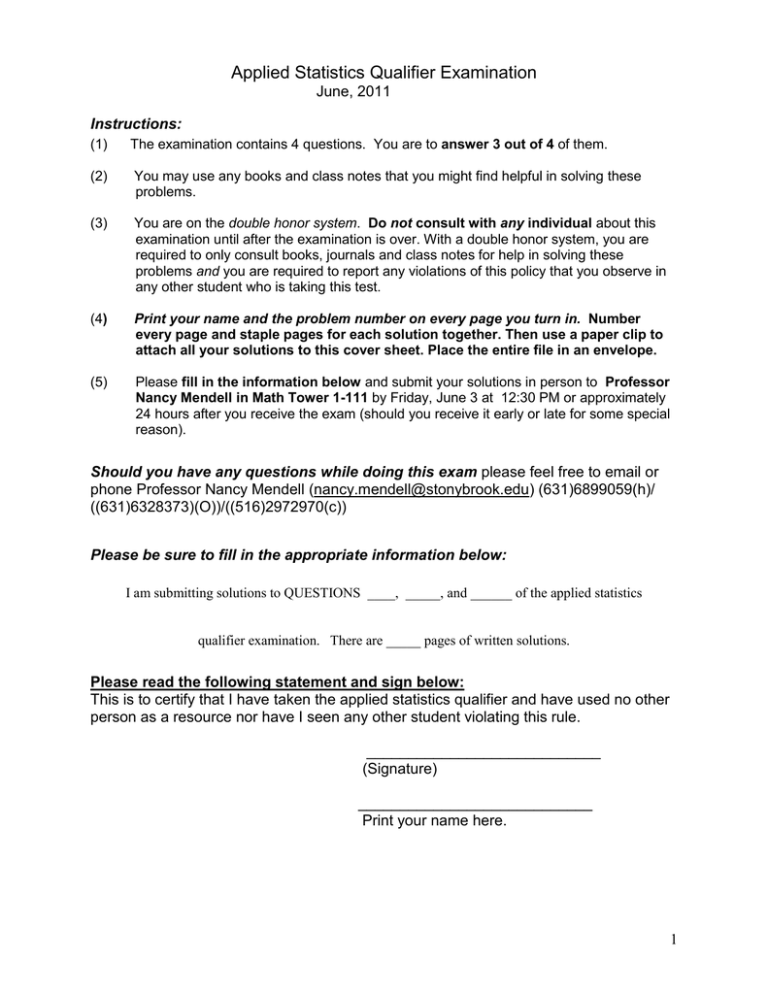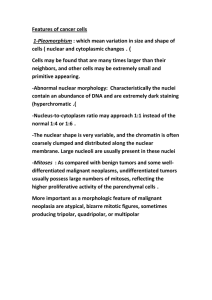Applied Statistics Qualifier Examination June, 2011 Instructions:
advertisement

Applied Statistics Qualifier Examination June, 2011 Instructions: (1) The examination contains 4 questions. You are to answer 3 out of 4 of them. (2) You may use any books and class notes that you might find helpful in solving these problems. (3) You are on the double honor system. Do not consult with any individual about this examination until after the examination is over. With a double honor system, you are required to only consult books, journals and class notes for help in solving these problems and you are required to report any violations of this policy that you observe in any other student who is taking this test. (4) Print your name and the problem number on every page you turn in. Number every page and staple pages for each solution together. Then use a paper clip to attach all your solutions to this cover sheet. Place the entire file in an envelope. (5) Please fill in the information below and submit your solutions in person to Professor Nancy Mendell in Math Tower 1-111 by Friday, June 3 at 12:30 PM or approximately 24 hours after you receive the exam (should you receive it early or late for some special reason). Should you have any questions while doing this exam please feel free to email or phone Professor Nancy Mendell (nancy.mendell@stonybrook.edu) (631)6899059(h)/ ((631)6328373)(O))/((516)2972970(c)) Please be sure to fill in the appropriate information below: I am submitting solutions to QUESTIONS ____, _____, and ______ of the applied statistics qualifier examination. There are _____ pages of written solutions. Please read the following statement and sign below: This is to certify that I have taken the applied statistics qualifier and have used no other person as a resource nor have I seen any other student violating this rule. ____________________________ (Signature) ____________________________ Print your name here. 1 1. The attached data is simulated. A patient who is at risk of developing a disease has blood and tissue drawn. The amount of a protein in the patient's blood is an important precursor of the disease and is recorded as the variable Y, the variable in the second column of the data file. The leftmost column is a number indicating the patient’s identification and, in principle, should not be related to Y. The patient ID is between 1 and 700. The concentration of three potentially toxic chemicals in the patient's tissue is measured and recorded as variables X 1 , X 2 , and X 3 . These variables are recorded in the third through fifth columns from the left. There are nine genes that might be associated with Y. If the patient has a genotype on gene i that puts the patient at risk, the variable Gi is scored as 1; if the patient is not at risk, Gi is scored as zero. The values of these indicators are given in the next nine columns. The dependent variable may be associated with any gene, any chemical concentration, any interaction of chemical concentration and gene, any interaction of gene and gene, and more complex interactions. Analyze the data. In a short report, summarize each step in your data analysis and briefly discuss your findings on how the explanatory variables affect the dependent variable. Make sure that you clearly label and fully discuss your final model. You may have only one final model. 2 2. Below are conformity ratings of six groups for the three levels of self-esteem. Low 9 11 7 5 12 6 Moderate 4 6 3 7 5 5 High 2 4 3 0 2 4 (a) Use the Friedman test to detect differences in groups among the three levels of selfesteem with confidence level alpha = 0.05. Give the value of the Friedman statistic. (b) Find the approximate p-value for the test in part (a). What is your conclusion? (c) Perform an analysis of variance and give the ANOVA table for the analysis. (d) Give the value of the F-statistic for testing the equality of the four treatment means. Find the p-value for this F-statistic value. 3 3. For the inference on two population proportions with two independent samples, suppose the data are as follows: Sample 1 (population proportion -- 1 ): sample size -- n1 , total number of ‘successes’ -- X 1 Sample 2 (population proportion -- 2 ): sample size -- n2 , total number of ‘successes’ -- X 2 Furthermore, for each sample, the total number of successes and the total number of failures are all five or more. That is, we have two large independent samples. (a) Please derive the test for vs. , where c is a constant, at the significance level of α using the likelihood ratio test approach. (b) Please derive the test for vs. , where c is a constant, at the significance level of α using the pivotal quantity approach. (c) Please discuss the relationships between the tests derived in (a) and (b) above. 4 4. The frequencies in the table below are the results on those patients having a minimal reaction to breast cancer surgery (Morrison et al., 1973). The variables and categories are as follows: (1) Nuclear grade (G) (i) Relatively Malignant appearance (ii)Relatively Benign appearance. (2) Age of diagnosis (A) (i)under 50 (ii)50-69 (iii)70 or over (3)Center where patient was diagnosed (C)(i) Boston (ii)Glamorgan (4) Survival after 3 years(S) (i) No (ii) Yes The purpose of the study is to evaluate the effect of nuclear grade and to see if it is the same for the two centers. Nuclear Grade(G) G=Malignant G=Benign ---------------------------------------------------------------------------------------------------------------Age of Diagnosis(A) A=<50 A=50-69 A=70+ A=<50 A=50-69 A=70+ ---------------------------------------------------------------------------------------------------------------Center(C) Survival(S) ---------------------------------------------------------------------------------------------------------------Boston No 6 8 9 7 20 18 Yes 11 18 15 24 58 26 Glamorgan No Yes 16 16 14 27 3 12 7 20 12 39 7 11 (a) Make a graph or table which shows the ln(odds) of survival (no) with respect to age (A) for each nuclear grade (G) at each center(C). Interpret your table or graph in terms of effects of center on the relationship between Survival and Age, Survival and nuclear grade and the interaction between nuclear grade and age on Survival. (b) Evaluate the partial associations between nuclear grade, center, and age and the three way association between these variables. For this you might want to plot the log odds of Malignant vs. age for each center and then consider the mean age of each center at each level of nuclear grade. (c) Use logistic regression to evaluate whether nuclear grade (G), Age group (A) and center (C) or the two and three way interaction of these variables predict the outcome. If you do find a significant 3 way interaction then report the results for each center separately. (d) Write out the logistic regression model for predicting the log odds of survival. Do this separately for each Center if the any of the interactions with C (A*C, G*C or A*G*C) are significant) and separately for each age group if any of the interactions (A*G or A*G*C) are significant. (e) Use loglinear models to test for partial associations between these 4 variables and 3 way associations between these 4 variables. What do you conclude? (f) Write a report that summarizes your findings. In particular give the estimated odds ratio for failure to survive associated with having a nuclear grade of malignant. Be sure to give estimates of Age and/or center specific odds ratios if there is a C*G interaction, or a G*A or a C*G*A interaction. 5



